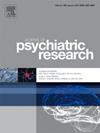Association of precarious employment with depressive symptoms and insomnia: Findings from the Korean Working Conditions Survey
IF 3.7
2区 医学
Q1 PSYCHIATRY
引用次数: 0
Abstract
Precarious employment (PE) is an important occupational health concern. This study aims to examine the relations between PE and depressive symptoms and insomnia in Korean workers. This study included a nationally representative sample of 49,420 adult workers. A modified version of the Employment Precariousness Scale (EPRES), which comprises six dimensions (temporariness, disempowerment, vulnerability, exercise of rights, uncertain work schedules, and wages), was used to quantify PE levels on a scale ranging from 0 to 100. PE levels were categorized into four groups based on quartile values. Depressive symptoms were assessed using the World Health Organization-5 Well-Being Index, and insomnia was assessed using the Minimal Insomnia Symptom Scale. Logistic regressions were performed, and odds ratios (ORs) and 95% confidence intervals (CIs) were estimated. The prevalence rates of depressive symptoms and insomnia were 10.7% and 8.4%, respectively. Compared with the lowest PE level, the highest PE levels were associated with both depressive symptoms (OR: 2.86, 95% CI: 2.61–3.14) and insomnia (OR: 1.33, 95% CI: 1.21–1.47). An interquartile range increase in the EPRES score was associated with a 1.84-fold (95% CI: 1.76–1.92) and 1.23-fold (95% CI: 1.17–1.29) increase in the odds of depressive symptoms and insomnia, respectively. All six individual dimensions were positively associated with depressive symptoms, whereas three dimensions—vulnerability, uncertain work schedules, and wages—were associated with insomnia. PE is a risk factor for depressive symptoms and insomnia. Policy interventions are required to safeguard mental health of precarious workers.
不稳定就业与抑郁症状和失眠的关系:韩国工作条件调查的结果。
不稳定就业(PE)是一个重要的职业健康问题。本研究旨在探讨韩国工人的不稳定就业与抑郁症状和失眠之间的关系。这项研究包括一个具有全国代表性的 49 420 名成年工人样本。该量表包括六个维度(临时性、丧失权力、脆弱性、行使权利、不确定的工作时间安排和工资)。根据四分位值将 PE 水平分为四组。抑郁症状采用世界卫生组织-5 Well-Being 指数进行评估,失眠则采用失眠症状量表(Minimal Insomptom Scale)进行评估。进行了逻辑回归,并估算了几率比(OR)和 95% 的置信区间(CI)。抑郁症状和失眠的患病率分别为 10.7% 和 8.4%。与最低 PE 水平相比,最高 PE 水平与抑郁症状(OR:2.86,95% CI:2.61-3.14)和失眠(OR:1.33,95% CI:1.21-1.47)相关。EPRES 分数在四分位数之间的增加分别与抑郁症状和失眠几率增加 1.84 倍(95% CI:1.76-1.92)和 1.23 倍(95% CI:1.17-1.29)有关。所有六个个体维度都与抑郁症状呈正相关,而三个维度--脆弱性、不确定的工作时间安排和工资--则与失眠相关。PE 是抑郁症状和失眠的风险因素。需要采取政策干预措施来保障不稳定工人的心理健康。
本文章由计算机程序翻译,如有差异,请以英文原文为准。
求助全文
约1分钟内获得全文
求助全文
来源期刊

Journal of psychiatric research
医学-精神病学
CiteScore
7.30
自引率
2.10%
发文量
622
审稿时长
130 days
期刊介绍:
Founded in 1961 to report on the latest work in psychiatry and cognate disciplines, the Journal of Psychiatric Research is dedicated to innovative and timely studies of four important areas of research:
(1) clinical studies of all disciplines relating to psychiatric illness, as well as normal human behaviour, including biochemical, physiological, genetic, environmental, social, psychological and epidemiological factors;
(2) basic studies pertaining to psychiatry in such fields as neuropsychopharmacology, neuroendocrinology, electrophysiology, genetics, experimental psychology and epidemiology;
(3) the growing application of clinical laboratory techniques in psychiatry, including imagery and spectroscopy of the brain, molecular biology and computer sciences;
 求助内容:
求助内容: 应助结果提醒方式:
应助结果提醒方式:


